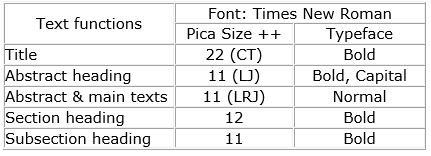Author Guidelines
Papers of research reports and articles with scientific merit will be judged for publication under careful consideration from reviewers. Such research reports and articles include those containing substantially supported theories, innovative works, substantial experimental results and/or containing useful and constructive discussions or reviews standardized to regional or international acceptance. The editor reserves the right to recommend for revision as a condition for final acceptance.
Manuscripts are reviewed by 2-4 referees specializing in related fields. This journal has adopted a double-blind reviewing policy whereby both the referees and author(s) remain anonymous throughout the process. Therefore, the name and affiliation of the author(s) should not be included in the manuscript. After the reviewing process, suggestions and comments from the reviewers will be summarized before passing them to authors. In submitting the manuscript, the author(s) transfers the copyrights to the journal, but still accepts any legal consequence for having the paper published.
The manuscripts should be prepared using Word or LaTeX with Science & Technology Asia Template:
- Word file / PDF file for Word;
- LaTex file / PDF file for LaTex.
Manuscript Preparation Guide
Text Format
Manuscript template is available upon request. The manuscript should be prepared using a text processing software such as Microsoft Word for Windows. B5 size paper is recommended. Page layout margins should be as follows:
- Top 2.0 cm.
- Bottom 2.0 cm.
- Left 1.5 cm.
- Right 1.5 cm.
There should be 2 sections. The first section is in a single column format. The second is formatted as two 6.95 cm-wide columns per page with a section separation of 0.8 cm. Title, author(s), address(es) for correspondence (indicating department, university/organization, country) and abstract should be in the first section while the remainder of the paper should appear in the second section.
Manuscript components
1. Title should be concise, specific, and informative. It should be located in the middle of the page.
2. The abstract should summarize the manuscript contents and should contain no more than 250 words. It should be justified to both margins. The word “ABSTRACT” should be capitalized.
3. Keywords relevant to the work presented in the manuscript should be listed below the abstract. Three to five keywords should be provided.
Font, Font Size & Typeface
Times New Roman font type is recommended. Font size (in Pica) and typeface for various text functions are tabulated as follows:
+ Including “Abstract” “Acknowledgement” and “References”
++ CT = Centre text, LJ = Left Justified, LRJ = Left & right justified
Line Art Figures
Can be drawn using several packages such as Win Draw, Auto CAD®, Corel Draw®, VISIO® etc.
Photographs
Original photographs should be clear with highest resolution and are appropriately inserted along the text.
Graphs
Several packages can produce nice-looking and professional graph presentation. Some also provide curve-fitting functions which are quite useful.
Equations & Complex Expressions
Always take time not only in typing but to manage this task. Math CAD, Math Writer, and Equation Editor (included in Microsoft Word) are acceptable. The manuscript should also be prepared using single space typing or it can be 1 ½ spaces if the font type is Times New Roman.
Acknowledgments and References
Acknowledgments should be as brief as possible in a separate section prior to the references. References should be numbered sequentially and these numbers should appear in brackets throughout the text. Vancouver style is used for reference.
Examples are as follow:
Reference to a journal article:
[1] Karlsson KG. Development of an operational cloud classification model. Int J Remote Sensing 1989;10:687-93.
Reference to a book:
[2] Old RW, Primrose SB. Principles of gene manipulation. Oxford: Blackwell Scientific Publications; 1980.
Reference to a book chapter:
[3] Esclamado R, Cummings CW. Management of the impaired airway in adults. In: Cummings CW, Fredrickson JM, Harker LA, Krause CJ, Schuller DE, editors. Otolaryngology-head and neck surgery. 2nd ed. St. Louis, MO: Mosby Year Book; 1993. p. 2001-19.
Reference to a thesis:
[4] Sakkayawong N. Application of chitin of textile wastewater treatment [Ph.D. thesis]. Bangkok: King Mongkut’s University of Technology Thonburi; 2006.
Reference to an electronic data source:
[5] ISI Journal Title Abbreviations [Internet]. [cited 2017 Mar 23]. Available from: https://www.efm.leeds.ac.uk/~mark/ISIabbr/
[6] Wikipedia. Pharmaceutical engineering [Internet]. [cited 2017 Mar 23]. Available from: https://en.wikipedia.org/wiki/Pharmaceutical_engineering
[7] US Food and Drug Administration. Influenza virus vaccine safety & availability [Internet]. [cited 2017 Mar 23]. Available from: https://www.fda.gov/BiologicsBlood Vaccines/SafetyAvailability/VaccineSafety/UCM110288


